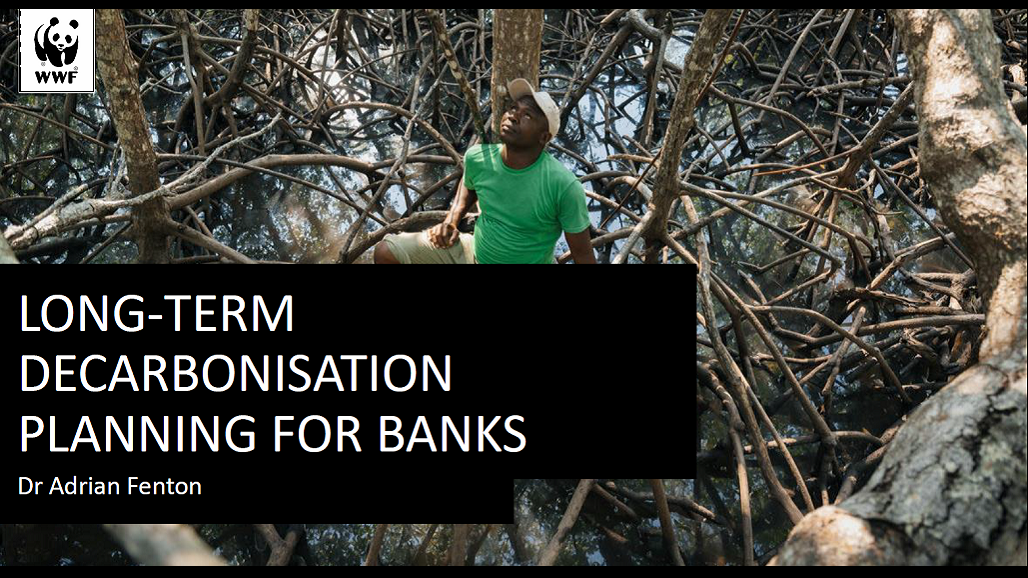Long-Term Decarbonisation Planning for Banks
(1) Introduction
 Climate change is used here in reference to the change in global atmospheric conditions and climate attributable to human activity. The overwhelming consensus is that human activities since pre-industrial levels has led to an increase in global average temperature by approximately 1°C1. Climate change is widely considered one of the greatest existential problems currently facing humanity.
Climate change is used here in reference to the change in global atmospheric conditions and climate attributable to human activity. The overwhelming consensus is that human activities since pre-industrial levels has led to an increase in global average temperature by approximately 1°C1. Climate change is widely considered one of the greatest existential problems currently facing humanity.
Globally, many stakeholders have officially politically declared the situation an ‘emergency’, including fourteen national governments and almost two thousand sub-national governments. Generally, these declarations recognise that urgent action is required to halt climate change. What ‘urgent action’ means is often undefined, but ‘emergency’ declarations tend to result in enhanced legislative, policy, and budgetary powers to resolve the situation.
The growing number of declarations should be interpreted as a signal that populations around the world are increasingly expecting their governments to significantly increase efforts to address climate change.
(2) The Paris Agreement of the UNFCCC
Global efforts to tackle climate change either directly or indirectly take their direction from the Paris Agreement, adopted by 192 countries around the world under the United Nations Framework Convention on Climate Change (UNFCCC) at its 21st Conference of the Parties in 2015.
For financial institutions, the key section is Article 2, under which countries agreed to:
(a) Holding the increase in the global average temperature to well below 2°C above pre-industrial levels and pursuing efforts to limit the temperature increase to 1.5°C above pre-industrial levels, recognizing that this would significantly reduce the risks and impacts of climate change;
(b) Increasing the ability to adapt to the adverse impacts of climate change and foster climate resilience and low greenhouse gas emissions development, in a manner that does not threaten food production.
(c) Making finance flows consistent with a pathway towards low greenhouse gas emissions and climate-resilient development.
The last element of Article 2 is pivotal to efforts to address climate change. Previously the role of the financial system in inadvertently facilitating climate change was largely ignored. Focus instead was largely on public finance. However, the agreement of Article 2.1 (c) means the financial system and its links to climate change have become centre stage, providing an undisputable signal that increased focus and regulation in relation to banks and climate change is to be expected.
Nationally Determined Contributions (NDC) are another important element of the Paris Agreement, signifying each country’s proposed contribution to tackling climate change. Importantly, NDCs will be periodically increased under a ‘ratcheting mechanism’ until Article 2.1 has been achieved2. Current NDCs and current efforts are massively insufficient for Article 2.1 to be achieved3. Consequently, banks should expect NDCs to increase which will impact on their investments and clients.
National Adaptation Plans (NAPs) and Low-Emission Development Strategies (LEDS) are the other important elements of the Paris Agreement. NAPs outline how a country will manage increasing physical risks associated with climate change. LEDS outline how a country will decarbonise their economy over the long-term; the current expectation is that LEDS plan for a net-zero transition by 2050. Banks should be aware of NAPs and LEDS as they will impact their investments and clients.
(3) Supervision and disclosure of climate-related finance risks
The Paris Agreement was quickly followed by the creation of the ‘Network of Central Banks and Supervisors for Greening the Financial System’ (NGFS) in 2017. The NGFS has led to increased attention into how banks inadvertently facilitate climate change and how a changing climate and decarbonisation efforts could affect all financial institutions. The creation and growth of the NGFS should be recognised by banks as a signal of further supervision of climate related financial risks.
The creation and efforts of the Task Force on Climate-related Financial Disclosures (TCFD) cemented the notions of ‘transition risk’ and ‘physical risk’, which are now essential terms of the climate change lexicon4. Focus has been on transition risk, which largely denotes the risks to which financial institutions are exposed due to decarbonisation efforts. Physical risks, largely denote the dangers which physical climate impacts impose on financial institutions, both directly and indirectly.
Many stakeholders are increasing focus on the disclosure of transition risks by financial institutions, ranging from central banks and financial regulators, credit risk agencies, investors, and civil society organisations. Disclosure is likely only the start. In Australia, the Hutley legal opinion5 found directors not properly managing climate risk could be held liable for breaching their legal duty of due care and diligence. Inadequate management of climate risks could become a significant legal issue for banks.
The main framework for disclosing climate-related financial risks is the framework proposed by the TCFD. This framework is the de facto basis of many emerging disclosure requirements by stakeholders, including regulators. This framework requests financial institutions to describe:
- Board’s oversight of climate-related risks and opportunities.
- Management’s role in assessing and managing climate-related risks and opportunities.
- Climate-related risks and opportunities identified over the short, medium, and long term.
- Impact of climate-related risks and opportunities on strategy and financial planning.
- Resilience of strategies to different climate-related scenarios, including a 2°C or lower scenario.
- Processes for identifying, assessing, and managing climate-related risks as well as integrating them into the organisation’s overall risk management framework.
- Metrics used when assessing climate-related risks and opportunities in line with its strategy and risk management process.
- Scope 1, Scope 2, and, if appropriate, Scope 3 GHG emissions, and related risks.
- Targets used to manage climate-related risks and opportunities and performance against targets.
(4) Transition risk and the inevitable policy response
The exposure of banks to transition risks6 is of increasing concern as these risks themselves increase. Some of this increase is due to market forces, such as decreasing renewable energy costs. However, it is also because current NDCs and lack of LEDS which are inconsistent with the Paris Agreement.
This misalignment is expected to be corrected in what is coined the ‘inevitable policy response’ (IPR)7. In summary, the IPR theory states that the gap between current decarbonisation efforts and what is required to achieve the Paris Agreement will be resolved. This resolution is expected to be abrupt, caused by rapid government policy changes, resulting in significant market volatility, and capital rapidly shifting from high to low-carbon activities resulting in stranded assets.
The theory is considered relatively likely to occur. Current NDCs result in global average temperature increase of 3°C above preindustrial levels8, and so will have to increase with implications for the global financial system which is backing projects that will increase global average temperature relative to pre-industrial levels by over 4°C9. Banks will benefit from the IPR as it limits physical risks associated with climate change; however, credit risks associated with some clients will increase.
The IPR was mostly developed in mind of asset managers and owners, particular long-term investors. However, it equally applies to banks for whom clients will be exposed to inevitable policy changes. In anticipation of the IPR and the associated financial losses, banks should engage in forward looking scenario and strategic planning with attention given to strategic asset allocation, portfolio structure, governance approaches, and risk management responses.
(5) Science-based targets
Forward looking scenario and strategic planning requires setting climate related targets used to manage climate-related risks and opportunities and performance. Many banks have begun setting GHG reduction targets, often devised under specific initiatives, most notably UNEP-FIs Principles for Responsible Banking, which has 214 signatory banks, collectively worth $53 trillion, representing 40% of the banking industry10. However, more progressive initiatives exist including Collective Commitment to Climate Action11 and the Bankers for Net-Zero commitment12.
GHG reduction targets are built upon the GHG Protocol Corporate and Value Chain Accounting and Reporting Standards. Generally, three elements to GHG emissions have been identified:
- Scope 1 emissions – direct impacts from owned or controlled sources,
- Scope 2 emissions – indirect impacts from consumed electricity, heating and cooling,
- Scope 3 emissions – emissions resulting from businesses receiving financial resources and services, but not directly owned or controlled by the banks themselves.
Scope 3 emissions comprise the vast majority of the associated GHG emissions of banks. They are the most difficult to reduce but are those of most interest to stakeholders. This has led to the Science-Based Targets initiative (SBTi) developing specific guidance for commercial banks, asset managers, asset owners, and mortgage real estate investment trusts13. The SBTi14 is a respected platform for disclosing climate related targets for all businesses and seeks to:
- Define and promote best practice in emissions reductions and net-zero targets in line with climate science.
- Provide technical assistance and expert resources to companies who set science-based targets in line with the latest climate science.
- Bring together a team of experts to provide companies with independent assessment and validation of targets.
Banks which set ‘science-based targets’ commit to aligning lending and investment portfolios with the level of ambition required to achieve the goals of the Paris Agreement. As highlighted previously, this means the Science-Based Targets initiative is directly associated with Article 2 of the Paris Agreement, which banks should identify as the destination of the inevitable policy response by national governments and their central banks and financial regulators.
Making such a commitment can potentially result in substantial benefits to banks15:
- Build business resilience and competitiveness by increasing emphasis on identifying and capitalising on new commercial opportunities created by the low-carbon transition.
- Driving innovation through client engagement by developing innovative financial products and services that enable customers to reduce emissions in the real economy.
- Build credibility and reputation, by utilising the latest available science and are validated against robust criteria developed through a multi-stakeholder consultative process.
- Influence and prepare for shifts in public policy as financial institutions with science-based targets are positioned to meet future regulatory and national policy adjustments.
- Demonstrate leadership, financial institutions that undertake the target setting process lead the way and push the market toward the most credible and practical solutions.
Currently, 60 financial institutions have committed to SBTi, although the initiative for financial institutions is still in the pilot phase, involving Amundi, Bank J Safra Sarasin, Storebrand, Eurazeo, La Banque Postale, Mizuho Financial Group, De Volksbank, and Wells Fargo & Company.
The move towards science-based targets is not without limitations. The SBTi itself recognises that ‘it is unclear which specific actions by financial institutions will reduce real economy emissions’. Currently, it is impossible to adequately measure the current and future impact of actions by financial institutions to address climate change. Precise and universally accepted methods may never exist. It is increasingly accepted that perfection should not be the enemy of progress and that science-based targets, though limited, is what currently exists, and that anticipation of future precise and universally accepted methods should not deter immediate efforts.
(6) Client engagement
Managing Scope 3 emissions requires that either banks drop or change clients, support clients to decarbonise, or off-set emissions. Dropping clients has flaws, most notably for banks for whom dropping clients directly impacts on profitability and so can only be pursued after significant internal debate. Civil society are also at odds with banks dropping clients because if these clients are simply served by other banks then nothing changes overall with regards to GHG emissions.
Carbon off-setting is still under scrutiny and conceptually underdeveloped16. International trading of emissions does occur, most notably with the EU Emission Trading Scheme. However, international negotiations have failed to create a true international carbon market. Additionally, many stakeholders believe it be a form of greenwashing and there are environmental, social, and governance issues surrounding many existing schemes.
Client engagement is becoming the generally accepted best course of action. Banks potentially can keep clients and clients keep their financial services. However, without credible consequences for not transitioning business models, or engagement fails to provide adequate support then engagement will likely fail, particularly if clients can change financial services provider. Civil society can be wary about the sincerity of engagement strategies as they can maintain the status quo.
No definitive guidance exists regarding what client engagement strategies should entail. An issue is that a lot of guidance will inevitably be sector and client specific. However, the following components (as well as their public disclosure) are likely to be expected to form part of all client engagement strategies:
- Timeline: adopting a decarbonisation target, and the development of a clearly articulated and detailed implementation plan for the gradual closure of relevant assets.
- Sale of assets: in certain instances stakeholders may expect asset sale (instead of closure) to be treated with a similar gravity as norm-based violations, most notably coal assets.
- Lobbying: disclosure of lobbying practices (including through industry associations) and intervene if there is demonstrated industry capture of key legislative files.
- Legal cases: disclosure of relevant legal cases that hamper the low carbon transition.
- Board nominations: disclosure of board candidate nominations aptitude and track-record regarding relevant climate change issues.
- Remuneration: whether executive remuneration policies are linked to the achievement and delivery of climate related targets.
- Escalation strategy: consequences for non-disclosure or failing to comply with mutually agreed targets and requests.
(7) Summary
The signals stemming from the Paris Agreement all indicate likely increased desire and requirements for enhanced disclosure and management of climate-related financial risks. These risks are expected to rise, potentially abruptly if the inevitable policy response scenario occurs as many expect.
Forward-looking scenario and strategic planning is the most accepted way for banks to proactively address climate-related financial risks and seize opportunities associated with the market volatility resulting from the transition to low-carbon economies internationally agreed by governments.
Target setting will be a difficult challenge and inevitably a long-term learning process. Most progress to date has been with multi-stakeholder efforts which – though new to the management and operational practices of banks – have yielded considerable benefits for all stakeholders.
The Science-Based Targets initiative is the most widely utilised multi-stakeholder initiative helping banks to develop targets which support forward-looking scenario and strategic planning in a manner which deals with the problems associated with the inevitable policy response.
The initiative certainly has limitations, such as methodological and data problems. However, perfection should not be the enemy of progress, and waiting is not a luxury banks have if they are to proactively address the transition risks associated with the low-carbon transition.
The presentation file can be downloaded HERE.
The video recording of ABA Policy Advocacy Committee Meeting can be viewed in the ABA YouTube.
Prepared for the Asian Bankers Association by:
 Dr. Adrian Fenton
Dr. Adrian Fenton
Vice President, Asia Sustainable Finance
World Wide Fund for Nature (WWF) Singapore
References:
1 https://climate.nasa.gov/vital-signs/global-temperature/
2 https://www.carbonbrief.org/timeline-the-paris-agreements-ratchet-mechanism
3 https://www.nature.com/articles/s41467-020-15414-6/
4 To various degrees litigation risks are seen as a subcomponent of both transition and physical risks.
5 See https://cpd.org.au/2019/03/directors-duties-2019/
6 It should be noted that not all transition risks stem from policy
7 https://www.unpri.org/inevitable-policy-response/what-is-the-inevitable-policy-response/4787.article
8 https://www.carbonbrief.org/un-new-national-climate-pledges-will-only-cut-emissions-by-2-over-next-decade
9 Source: https://www.theguardian.com/business/2019/oct/15/bank-of-england-boss-warns-global-finance-it-is-funding-climate-crisis?CMP=share_btn_link
10 https://www.unepfi.org/banking/bankingprinciples/
11 https://www.unepfi.org/banking/bankingprinciples/collective-commitment/
12 https://volans.com/project/bankers-for-netzero/
13 https://sciencebasedtargets.org/sectors/financial-institutions
14 The SBTi is a collaboration between CDP, World Resources Institute, WWF, and the UN Global Compact. As of September 2020, 989 companies have joined the SBTi.
15 See https://sciencebasedtargets.org/resources/legacy/2020/10/Financial-Sector-Science-Based-Targets-Guidance-Pilot-Version.pdf
16 https://www.reuters.com/article/us-climate-change-carbon-offsets-idUSKBN2AP1FZ

